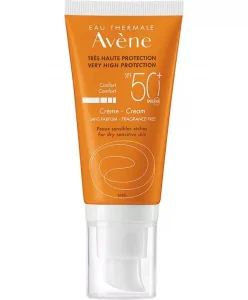
While applying sunscreen is an essential step in skin care, some SPF products can dry out your skin. That’s not exactly what you want to do if you already have dry skin. Fortunately, there are many moisturizing sunscreens in the market that can help boost moisture levels so your skin looks radiant, rather than dry and dull. In this article from The Dermo Lab, we will give you the best tips for choosing a sunscreen for dry skin.
How important is sun protection for dry skin?
Like everyone else, people with dry skin need to protect themselves with sunscreen every day. Wearing a broad-spectrum, high SPF sunscreen every day helps protect your skin from the sun’s potentially harmful rays. Sunburn, premature aging, and skin cancer are just a few of the possible side effects of exposure to harmful UVA and UVB rays.
What to look for in a sunscreen for dry skin
1- Appropriate sun protection
- Look for “broad spectrum” sunscreens that protect against both UVA and UVB rays. Mineral sunscreens, also known as physical sunscreens, contain ingredients such as zinc oxide and titanium dioxide, which are essential for protection against both UVA and UVB sunlight.
- It is important to pay special attention to SPF, also known as the sun protection factor. SPF measures the amount of UV radiation a sunscreen can filter out. An SPF of 30 blocks 97% of the sun’s UVB rays. A higher SPF doesn’t protect you any longer, but it does provide slightly more coverage. That said, no sunscreen can actually block 100% of the sun’s UVB rays.
2- It’s all in the ingredients
If your skin is dry, finding a sunscreen that not only protects your skin but also offers the added benefit of hydration can be a daunting task. Sunscreens containing the following ingredients provide that extra moisture to your skin, improving the elasticity and cohesion of the skin barrier.
- Hyaluronic acid: Hyaluronic acid is a key molecule in skin aging and hydration. This molecule helps retain moisture in the skin.
- Glycerin: Glycerin is a specific type of moisturizing ingredient called a humectant, which means that it helps bring water back into the skin and prevent further water loss.
- Ceramide: Ceramide is a key ingredient in protecting the skin barrier and preventing water loss from the skin. Ceramides are skin lipids found in the top layer of the skin, also known as the epidermis.
- Niacinamide: Niacinamide is an effective moisturizing ingredient that works by increasing the production of essential skin proteins (filaggrin) and lipids (ceramides). These proteins and lipids are essential because they are frequently altered in people with dry skin and eczema.
- Shea butter: Shea butter, derived from the fruit of the shea tree, has soothing and moisturizing effects.
3- Avoid common skin irritants
Exposure to the following ingredients, which can trigger rashes or redness, can make dry skin worse:
- Fragrance: Fragrance may be appealing when purchasing sunscreen, but fragrance is a common skin allergen and can aggravate dry skin.
- Botanical or “plant-derived”: Despite the term “all-natural”, some botanical ingredients can aggravate and irritate dry skin and cause rashes and redness.
If you’re concerned about being allergic to any of the chemicals in the sunscreen, choose a sunscreen for sensitive skin. This type of sunscreen does not contain any chemical absorbers and ensures optimal protection without any skin irritation.
4- Look for a light formula
- Sunscreens for dry skin should be moisturizing, but at the same time not heavy or occlusive. Look for a sunscreen with a light texture that moisturizes the skin without leaving a greasy or oily residue.
The key to finding the right sunscreen is to look for nourishing ingredients. Are you looking for a sunscreen that will give you a beautiful, non-greasy glow? We’ve got just what you need! Discover the best sun protection cream for dry skin.
Eau Thermale Avène Very High Protection Cream SPF50+
This fragrance-free cream is ideal for dry and sensitive skin exposed to intense sunlight and/or prone to sunburn. It is water, sweat, and sand resistant. It keeps the skin protected and moisturized for up to 8 hours.
How does sun damage show up on dry skin?
The sun can make already dry skin even drier, giving it a flaky, cracked appearance that makes it look wrinkled and tired. The skin’s moisture content is reduced and the natural moisturizing factor (NMF) can be damaged due to the breakdown of the skin barrier. This leads to increased skin dryness.
Choose a sunscreen that contains ingredients such as ceramides, glycerin, and hyaluronic acid, which moisturize the skin. It should offer broad-spectrum protection and contain antioxidants to calm redness and enhance the skin’s anti-aging potential.
Tips for using sunscreen when you have dry skin:
1- Cleanse then protect:
It is generally recommended to apply sunscreen after gentle cleansing and moisturizing. If you use a moisturizer with SPF, it’s recommended to apply it to the skin before applying makeup.
2- Don’t skimp on the amount:
In general, it’s recommended to apply a coin-sized amount of sunscreen to the entire face. If you’re at the beach or pool, it’s recommended to apply a shot glass sized amount of sunscreen to all exposed skin. It is just as important to wear SPF on cloudy or overcast days as it is on sunny days.
In general, the sun’s rays are strongest between 10 am and 2 pm. Therefore, it is recommended to be diligent about SPF and sun protection at this time of day.
3- Reapplication is key:
Many people buy a higher SPF in hopes of not having to reapply. In reality, a higher SPF does not mean you can spend more time outdoors without protection. Reapplication is essential, especially after being in the water or after a vigorous workout. Reapplication also provides the added benefit of frequent skin hydration.
4- Don’t forget the backs of your hands:
The backs of your hands are often exposed to drying skin irritants such as soap, hot water, and antibacterial hygiene products. The back of the hands is a common site for non-melanoma skin cancers because it is frequently exposed to UVA/UVB rays on a daily basis, whether driving, walking, cycling, etc. Be aware that frequent hand washing can also remove sunscreen and reapplication is essential.
Last Updated on December 6, 2023










